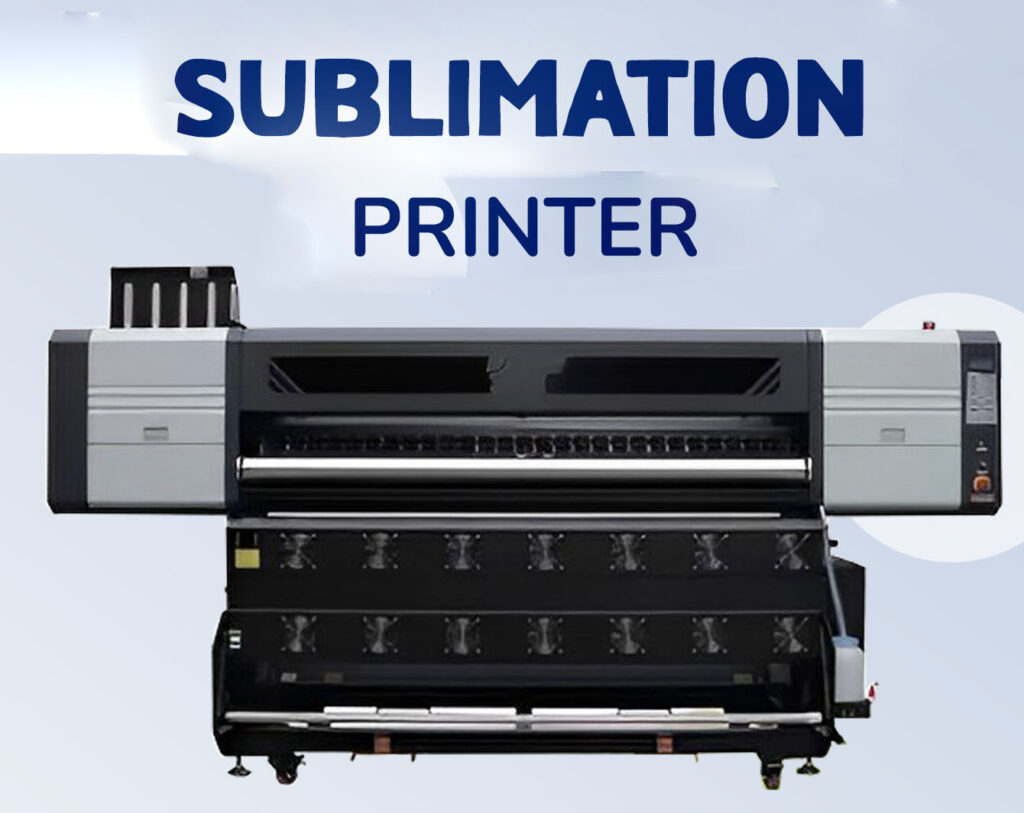BLOG
What Is Sublimation Printing? How Does Sublimation Printing Work?
What Is Sublimation Printing? How Does Sublimation Printing Work?
What Is Sublimation Printing?
Sublimation printing is a process that uses heat to transfer dye onto materials like fabric, plastic, and other specially coated items. The process involves printing a design onto a special sublimation paper using sublimation ink. This paper is then placed on the material to be printed, and heat and pressure are applied. The heat causes the ink to turn into a gas, which then permeates the fabric or material. As the material cools, the ink solidifies, resulting in a permanent, high-quality print.

Key Features of Sublimation Printing:
- Vibrant Colors: Sublimation printing produces bright and vivid colors that are embedded into the material, resulting in a high-quality and durable print.
- No Feel on Fabric: Since the ink becomes part of the fabric, there is no additional layer on top of the material, making the design feel soft and smooth.
- Durability: Sublimated designs are long-lasting and resistant to fading, cracking, or peeling over time, even after many washes.
- Material Compatibility: Works best on polyester fabrics and specially coated materials.
Comparing Sublimation Printing with Other Printing Methods
1. Sublimation Printing vs. Screen Printing
- Color Quality: Sublimation printing offers more vibrant and detailed colors compared to screen printing, which is limited to fewer colors at a time and may result in less detail.
- Durability: Sublimation prints are more durable and resistant to wear, while screen prints may crack or peel over time.
- Material Compatibility: Sublimation works best on polyester and coated materials, while screen printing can be done on a wide range of fabrics including cotton.
- Feel: Sublimation prints feel smooth to the touch with no noticeable texture, whereas screen printing creates a raised texture on the fabric.
2. Sublimation Printing vs. Heat Transfer Printing
- Process: Both methods use heat, but sublimation turns ink into gas and integrates it into the material, while heat transfer printing involves applying a layer of design onto the fabric.
- Durability: Sublimation offers more durable results as the ink is embedded into the fabric, whereas heat transfer designs may peel, crack, or fade over time.
- Color and Detail: Sublimation allows for detailed, high-resolution prints with vibrant colors, while heat transfer can result in a lower resolution and less vivid colors.
- Material Compatibility: Sublimation is limited to polyester and coated materials, whereas heat transfer can be used on various fabrics, including cotton.
3. Sublimation Printing vs. Direct-to-Garment (DTG) Printing
- Color Quality: Both methods can produce vibrant and detailed prints, but sublimation typically offers brighter colors, especially on light-colored polyester fabrics.
- Material Compatibility: DTG can print on a wider variety of fabrics, including cotton, whereas sublimation is limited to polyester and coated items.
- Feel and Finish: DTG prints sit on top of the fabric, often resulting in a slightly raised texture, while sublimation prints are embedded into the fabric, leaving no texture.
- Durability: Sublimation prints tend to be more durable and resistant to fading compared to DTG prints, which may fade slightly over time.
How Does Sublimation Printing Work?
Sublimation printing is a process that uses heat to transfer dye onto materials like fabric, plastic, or specially coated items. Here’s how it works:
1. Preparing the Design
- Digital Design: The first step is creating a digital design using graphic design software like Adobe Photoshop or Illustrator. This design will be printed using special sublimation ink.
2. Printing the Design
- Sublimation Paper: The design is then printed onto sublimation paper using a specialized printer equipped with sublimation ink. This paper is coated with a special layer that holds the ink before it is transferred to the material.
3. Transferring the Design
- Heat and Pressure: The sublimation paper is placed on the surface of the material, typically polyester fabric. A heat press is used to apply high temperature (around 180-200°C or 356-392°F) and pressure for a short period (about 60 seconds).
- Sublimation Process: When heated, the sublimation ink turns from a solid to a gas without passing through a liquid state (a process known as sublimation). The gas then permeates the fabric fibers, and as the material cools down, the ink solidifies, creating a sharp and permanent print.
4. Final Product
- Completed Design: Once the sublimation process is complete, the sublimation paper is removed, and the design is now embedded into the fabric or material. The print is vibrant, durable, and resistant to fading, cracking, or peeling.
Advantages and Disadvantages of Sublimation Printing
Advantages:
- Vibrant and Durable Colors:
- Sublimation printing produces bright and vivid colors that are embedded directly into the material, resulting in prints that are long-lasting and resistant to fading, cracking, or peeling.
- Soft Feel:
- Since the ink becomes part of the fabric, there is no additional layer on top, giving the material a smooth and soft feel without the stiffness that can occur with other printing methods.
- No Color Limitations:
- Sublimation allows for a wide range of colors and detailed designs, making it ideal for creating complex and multicolored images.
- Eco-Friendly:
- Sublimation printing is a relatively eco-friendly process as it produces minimal waste. The inks are water-based and do not require any additional chemicals for processing.
- Versatility:
- It can be used on various products, such as apparel, mugs, phone cases, and more, as long as the material has a polyester coating or is made of polyester.
Disadvantages:
- Material Limitations:
- Sublimation printing works best on polyester or polyester-coated materials. It is not suitable for natural fibers like cotton, limiting the types of products that can be printed.
- Requires White or Light-Colored Base:
- The process works best on white or light-colored materials because the inks are transparent. Printing on dark materials may result in dull colors or may not be visible at all.
- Initial Setup Cost:
- The cost of sublimation printers, heat presses, and other specialized equipment can be high, making the initial investment more expensive compared to other printing methods.
- Size Limitations:
- Sublimation printing is generally limited to smaller items or flat surfaces unless specialized equipment for larger items is used.
- Time-Consuming for Large Orders:
- Each item must be individually prepared and pressed, which can be time-consuming when dealing with large orders, making it less efficient than some other mass production printing methods.
Design Tips for Sublimation Printing
When preparing designs for sublimation printing, certain guidelines can help ensure the best results. Here are some key design considerations:
1. High-Resolution Files
- Tip: Use high-resolution images (at least 300 DPI) to ensure clarity and detail in the final print. Blurry or pixelated designs will not produce sharp results.
2. Bright and Vivid Colors
- Tip: Sublimation printing excels at producing bright, vibrant colors. Utilize bold and saturated colors to take full advantage of the process’s color capabilities.
3. Light or White Backgrounds
- Tip: Sublimation inks are transparent, making them best suited for light or white backgrounds. Designs on dark materials may not show up well or could require special treatments.
4. Simplify Gradients and Shadows
- Tip: While sublimation can handle gradients, complex or subtle gradients might not reproduce perfectly. Keep gradients simple and avoid excessive shadow details.
5. Vector Graphics
- Tip: Use vector graphics whenever possible. Vector files (like those created in Adobe Illustrator) can be resized without losing quality, which is ideal for sublimation printing.
6. Accurate Color Profiles
- Tip: Ensure you use color profiles compatible with sublimation printers to maintain color accuracy. Convert designs to CMYK color mode to match the printer’s color process.
7. Margin Around Edges
- Tip: Leave space around the edges of your design to prevent important elements from being cut off. This also helps in aligning the design properly on the material.
8. Test Prints
- Tip: Conduct test prints on the actual material to see how colors and details transfer. This helps identify any necessary adjustments before proceeding with larger quantities.
9. Material-Specific Design
- Tip: Consider the type of material you’re printing on. For example, designs for mugs or phone cases need to account for curved surfaces, while t-shirt designs should fit comfortably within the printable area.
10. Avoid Small, Detailed Text
- Tip: Fine text may not reproduce well in sublimation printing. Use clear, legible fonts and avoid very small text sizes to ensure readability.
By following these design tips, you can create artwork that leverages the strengths of sublimation printing, resulting in high-quality and visually appealing prints.


